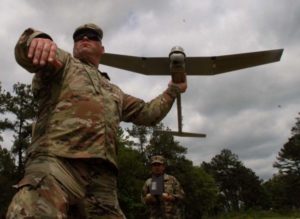 Army drones are headed to basic training – but this time, UAV tech will be doing the training.
Army drones are headed to basic training – but this time, UAV tech will be doing the training.
The Army’s 316 Cavalry Brigade cut the ribbon on a new drone training facility last week to provide more space and functionality to its UAS education program.
Fittingly, a soldier-piloted quadcopter cut the ribbon with a pair of red and white scissors, slicing the paper in half.
“Unmanned aerial systems are the way the future,” Lt. Col. Jeffrey Barta said during the ceremony.
“This new school can grow to become the center for aerial robotics in conjunction with the [nearby Georgia city of] Columbus through partnership with industry and education.”
Barta added:
“This building represents an incredible new opportunity to the small unmanned aerial system course. For several years now, it was operating in a small, cramped classrooms insufficient to meet program instruction requirements. Thanks to the work many on the squadron staff, the 316th Brigade S4 shop, and the garrison Directorate of Public Works and Network Enterprise Center, we were able to turn the vacant structure into a vibrant classroom, training leaders to make the Army better.”
Among other topics, the UAS center will teach soldiers how to use drones in combat situations to provide reconnaissance and locate enemy drones.
The program will focus on Raven and Puma fixed-wing drones as well as the Instant Eye microdrone, which “flies as quietly as a humming bird.”
“Our enemies have drones now,” Capt. Sean Minton said. “And we don’t always own the air.”
In 2016, Fort Benning’s Maneuver Center of Excellence launched a new set of standards for pocket-sized drones. Dubbed Soldier Borne Sensors, the tiny UAVs can scout locations and maximize risk assessment.
The standards call for the drones and controller to weigh no more than 150 grams and be able to fly 1.2 km within line of sight in winds up to 150 knots.
Jason is a longstanding contributor to DroneLife with an avid interest in all things tech. He focuses on anti-drone technologies and the public safety sector; police, fire, and search and rescue.
Beginning his career as a journalist in 1996, Jason has since written and edited thousands of engaging news articles, blog posts, press releases and online content.
Email Jason
TWITTER:@JasonPReagan
Subscribe to DroneLife here.







[…] Source link […]